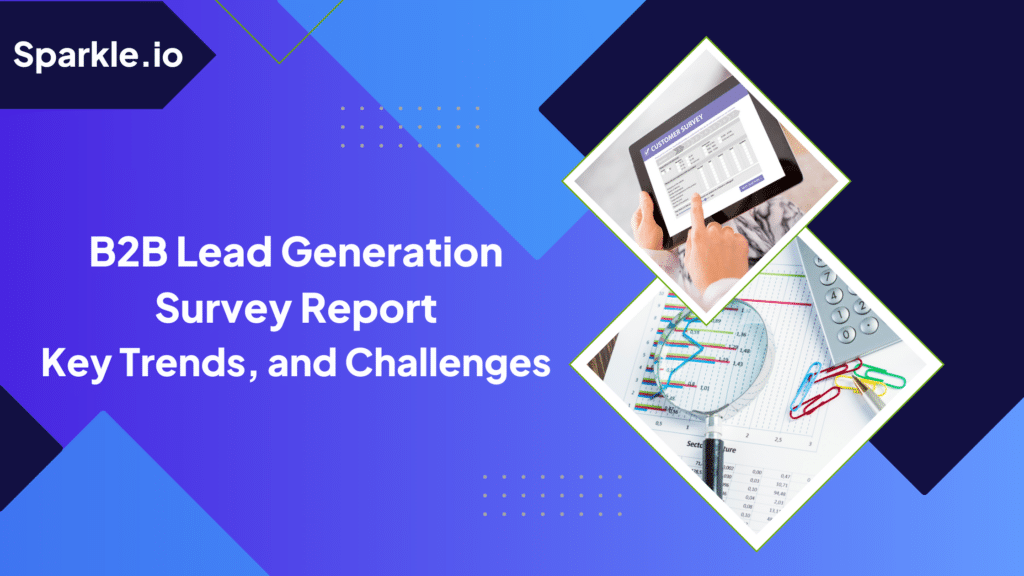
Businesses understand the advantages of outsourcing lead generation and appointment setting as the market for these activities becomes more lucrative, saving time and resources and improving ROI.
To learn more about 151 lead generation and sales professionals’ approaches and viewpoints, ContentMarketing.io conducted a thorough survey of them.
The study provided insightful data on their preferred lead generation strategies, the various industries they serve as clients, and how they use AI solutions.
In addition, we gathered information on the problems they faced, specifically, the funds they were given, the timing of their investments, and the key performance indicators (KPIs) that were vital for monitoring their development.
Table of Contents
Key Findings
- 63.58% of professionals use ChatGPT and GPT-3 to boost lead generation and sales.
- A large percentage (74.83%) of professionals plan to integrate AI tools into their lead generation and sales strategies within the following year.
- 82.78% of respondents believed AI solutions could streamline work processes and boost productivity.
- Marketing & advertising (31.13%), technology & IT services (27.15%), and SaaS (19.21%) are the top three industries lead generation and sales professionals work with.
- The most popular lead generation techniques used by professionals are cold email (69.54%), social media outreach (66.23%), and email marketing (opt-in) (61.59%).
- The top options among respondents for gathering industry contact information, leads, and sales automation were Apollo.io (50.33%) and Hunter.io (46.36%)
- Lead generation presents sales teams with various difficulties, such as finding reliable contact information, creating efficient plans, obtaining enough funding, nurturing leads, connecting with decision-makers, and handling phony leads.
- The majority of respondents (63.58%) had a monthly budget for lead generation and setting up sales meetings of less than $10,000.
- In terms of budget distribution, 45.7% of respondents said that lead generation and appointment setting receive 15% to 50% of their sales and marketing budget.
- A sizable percentage of respondents (56.29%) invest in lead generation when necessary.
- Close rate, lead-to-appointment conversion ratio, total sales revenue, and the number of new leads in the pipeline are the top KPIs to gauge sales success.
About the Respondents
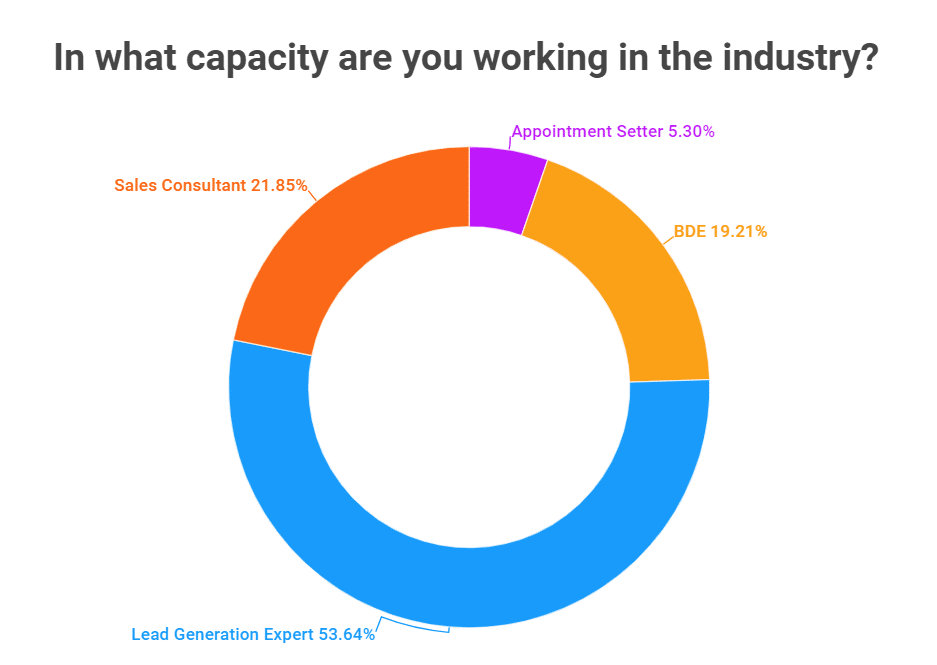
Lead Generation Experts
This group accounts for 53.64% of all respondents. Lead generation experts find business leads. They employ several methods to gather information and generate interest in their products and services.
Sales Consultants
Sales consultants account for 21.85% of respondents in the poll. Sales consultants advise on sales strategies and methods. They help clients boost sales and meet goals.
BDEs (Business Development Executives)
Approximately 19.21% of those polled identified themselves as Business Development Executives. BDEs find new clients, build relationships, and expand the company’s reach. They drive growth and collaboration.
Appointment Setter
This group comprises 5.3% of respondents. Appointment setters organize workplace meetings, appointments, and sales calls. They usually coordinate with prospective clients.
Sales Team Size
Regarding the size of sales teams, the survey answers tell us a lot about how the participants are distributed.
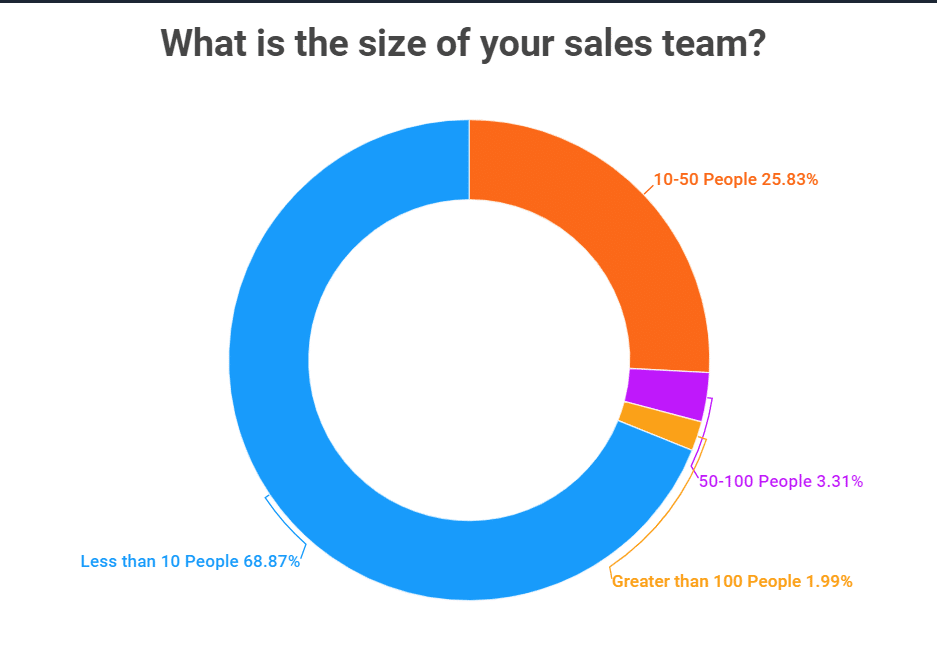
1. Small Sales Teams (Less than ten members)
Most respondents (68.87%) reported having sales teams with fewer than ten individuals. This suggests that a sizable percentage of participants have sales teams with a manageable number of sales specialists.
2. Medium-Sized Sales Teams (10–50 people)
According to 25.83% of survey participants, their sales teams include between 10 and 50 people. The fact that a sizable percentage of participants have medium-sized sales teams shows a moderate degree of sales resources and competencies.
3. Slightly Larger Sales Teams (50-100 members)
A lesser proportion of respondents, or 3.31%, reported having sales teams with 50–100 people. This indicates a significantly bigger scale of sales activities because it signifies that only a tiny percentage of participants have sales teams of this size.
4. Larger Sales Teams (Greater than 100 members)
According to the survey results, 1.99% of respondents have large sales teams that include over 100 people. This shows that a small percentage of participants have large sales operations and more personnel.
Lead Generation and Sales Tools
Businesses need lead generation and sales tools to improve sales and customer acquisition. These tools streamline sales and lead creation.
Lead generation tools are applications, platforms, and technologies used to automate and optimize finding potential customers. They also help sales teams to convert these leads into actual customers.
Using these sophisticated digital marketing tools, businesses may improve operations, lead management, customer connections, and revenue growth.
AI Tools
1. Current Usage of AI Tools in Lead Generation and Sales
Based on our survey results, it appears that many individuals in the lead generation and sales industry are leveraging AI tools to support their lead generation and sales efforts.
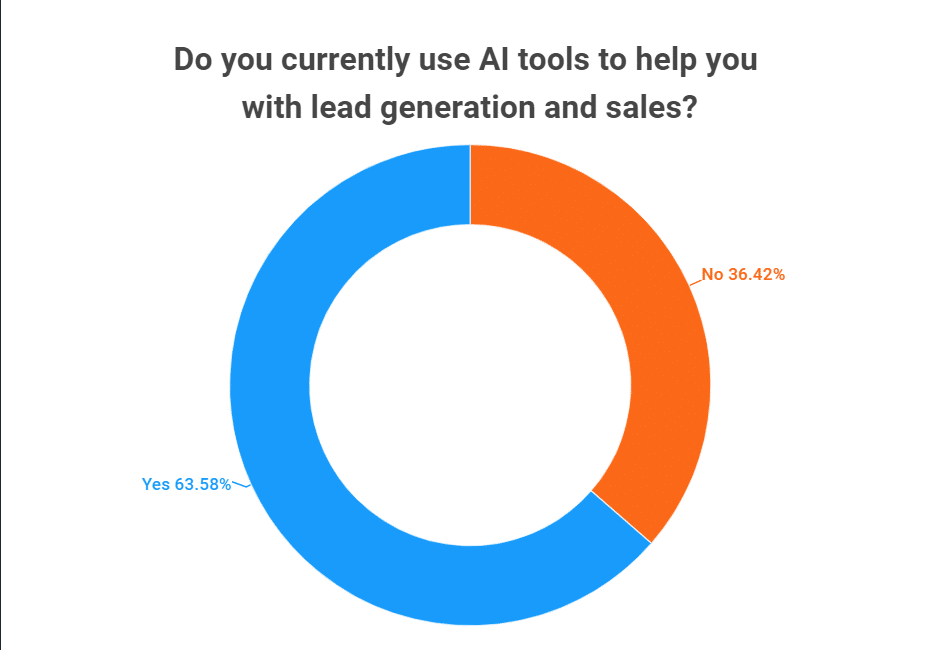
A majority of 63.58% of the respondents reported utilizing AI tools like Chat GPT and GPT-3. Interestingly, a significant percentage of professionals (36.42%) reported not utilizing AI tools for this objective.
Results show that more people are using AI for lead generation and sales. AI is becoming more popular and recognized in this industry, and sales professionals are getting significant results from adopting it.
2. Future Plans for AI Tools in Lead Generation and Sales
Many lead generation and sales professionals surveyed said they planned to use AI tools for their lead generation and sales operations in the upcoming year.
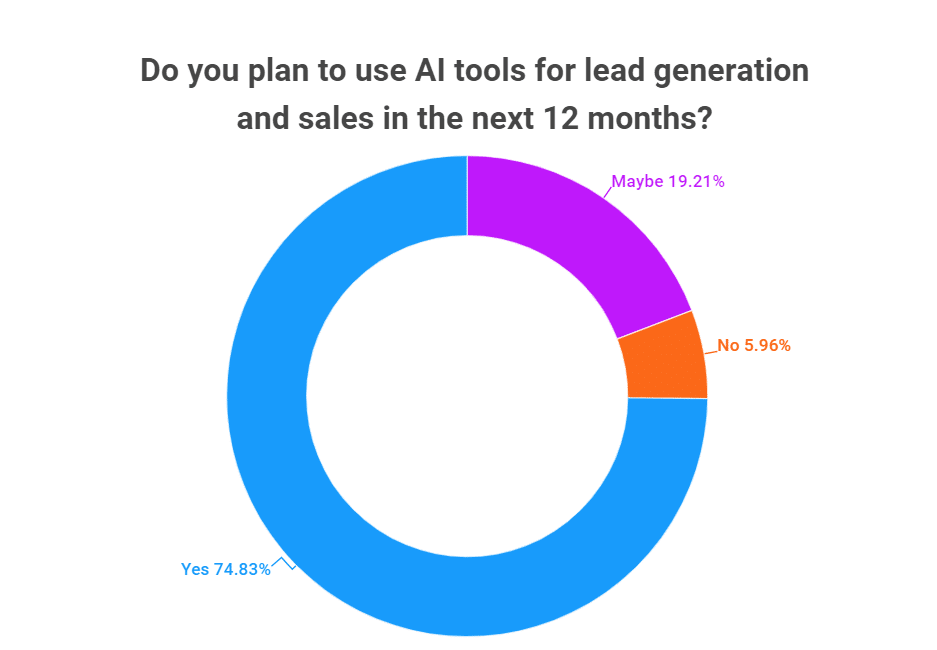
74.83% of respondents said they would use AI tools for this purpose. The 19.21% of respondents who said they were unclear or evaluating the option also indicated potential interest in implementing AI technologies. 5.96% of respondents, a relatively modest percentage, said they had no plans to use AI tools for lead generation and sales in the upcoming year.
These findings indicate that professionals want to employ AI to improve lead generation and sales.
3. Anticipated Impact of AI Tools on Lead Generation and Sales in the Future
The majority of respondents, 82.78%, expressed optimism and thought that AI tools would make their life easier when questioned about the projected influence of AI tools on lead generation and sales in the future.
They perceive AI as a vital tool that can improve and optimize their workflow, allowing them to perform their jobs more effectively.
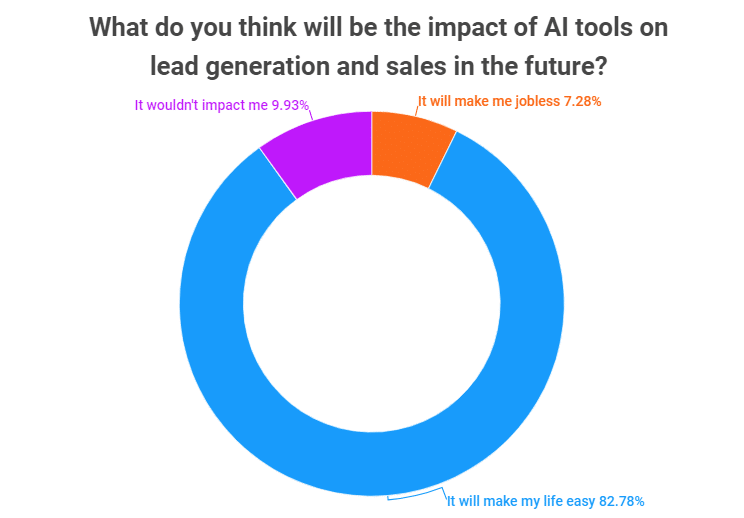
Only 7.28% of respondents expressed concern about the potential drawbacks of AI tools, claiming that they would lose their jobs. On the other hand, the same proportion, 9.93%, thought that using AI tools would have little to no impact on their jobs.
These replies show a variety of viewpoints, with the majority perceiving AI tools as helpful tools for increasing lead generation and sales efficiency and effectiveness. At the same time, a minority had concerns about possible job displacement.
Leads and Sales Automation Tools
1. Preferred Tools for Contact Information, Leads, and Sales Automation
A few technologies stand out as top picks among respondents for gathering industry contact information, leads, and sales automation.
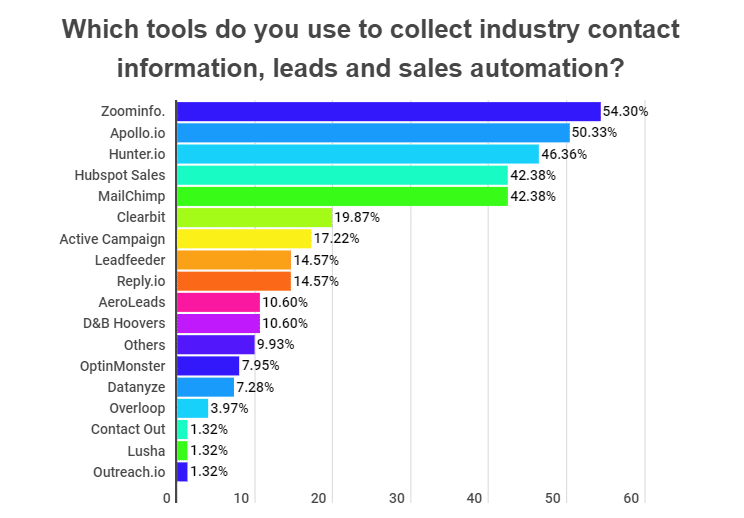
Zoominfo is the most often used tool, preferred by 54.30% of respondents. Apollo.io (50.33%) and Hunter.io (46.46%) and are not far behind. Hubspot Sales and MailChimp, which received an equal vote of 42.38% from respondents, are other well-liked options.
There were also other tools chosen by the respondents which were:
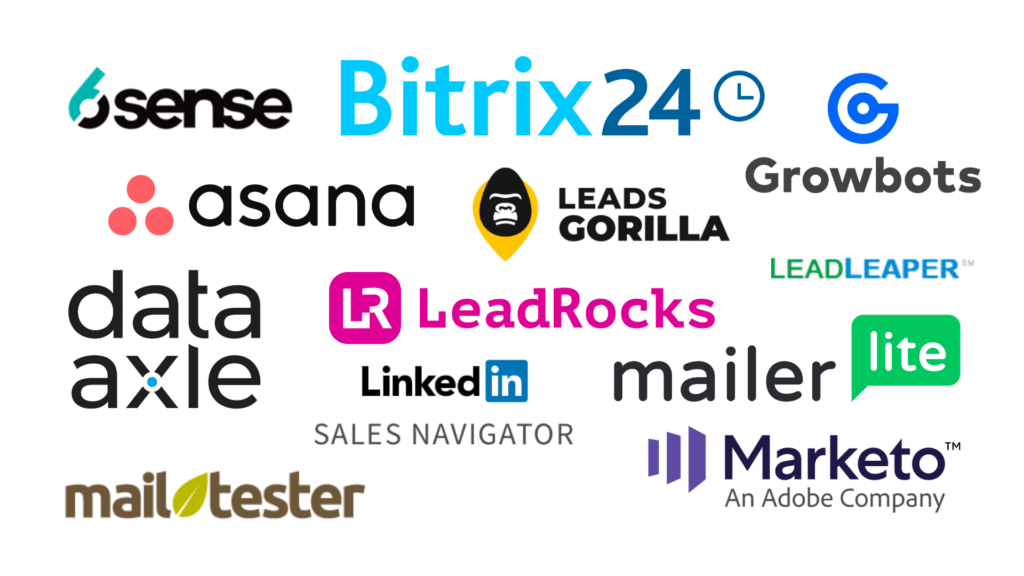
These solutions are valued because they help find contact information, generate leads, and improve sales automation.
2. Top Choice for Sales Automation Tool
Respondents listed their top choices for a single sales automation solution when asked.
Hubspot Sales was the most frequently chosen option, by 22.52% of respondents. Apollo.io, selected by 20.53% of respondents, came in second place.
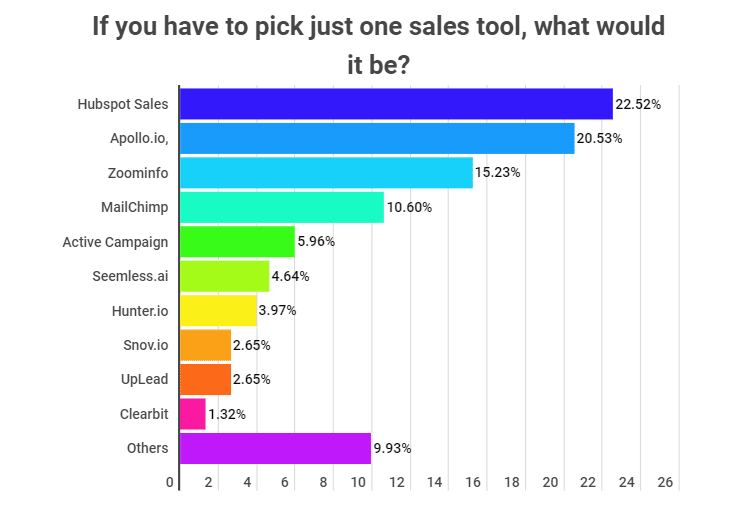
15.23% of respondents preferred Zoominfo, while 10.6% and 5.96% preferred MailChimp and ActiveCampaign. These technologies help sales teams simplify their work and be more efficient.
9.93% of the respondents prefer other tools such as:
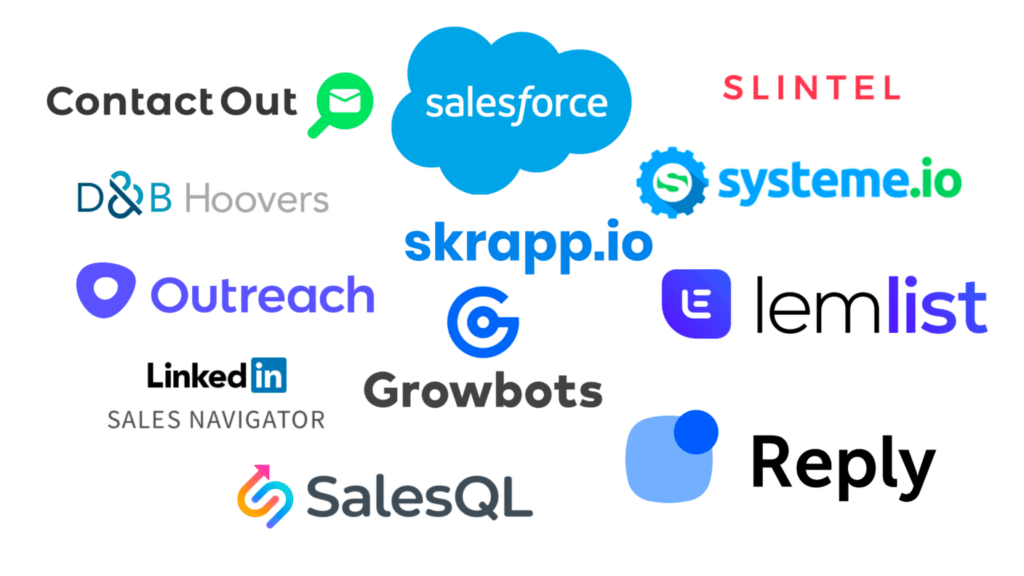
These recommended lead generation and sales automation systems reveal the industry’s technology landscape. They can help professionals engage prospects, nurture leads, and close deals faster and more accurately.
Lead Generation and Sales Strategies
Industry Clients in Focus:
The survey found that the respondents work in Marketing & Advertising, SaaS, and Technology & IT Services as the top three industries.
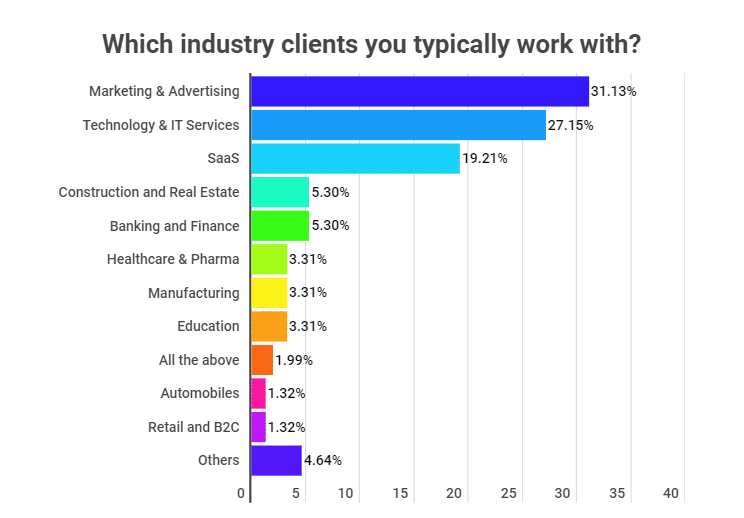
31.13% of respondents’ clients are in marketing and advertising, emphasizing the importance of lead generation and sales.
27.15% of respondents report working with technology and IT services clients. Additionally, 19.21% of respondents said that they frequently work with clients in the SaaS sector, highlighting the significance of lead generation and sales in this market.
These data shed light on the various clients of lead generation and sales professionals.
Lead Generation Methods
Cold calling, cold email, and social media outreach were the top lead-generating methods.
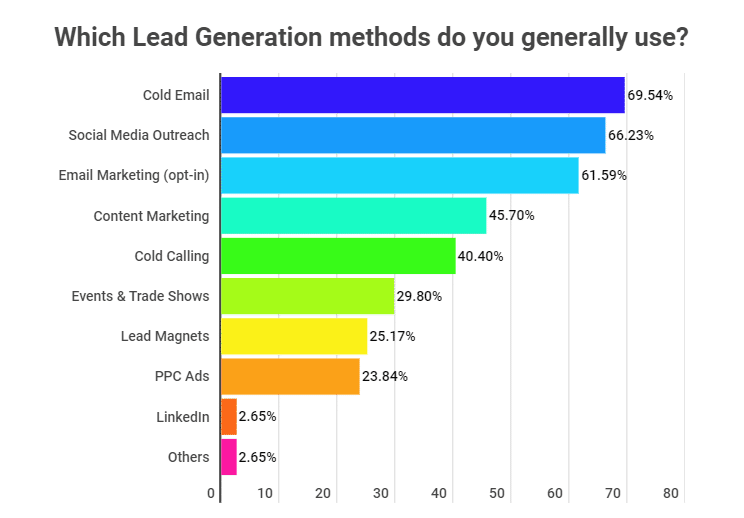
69.54% of those surveyed said they use cold email as their primary strategy for generating leads. This emphasizes the importance of using well-crafted emails to connect with potential clients.
Also, 66.23% claimed that they use social media outreach as a successful method for contacting prospects and starting conversations. In addition, 61.59% of respondents said they used email marketing (opt-in).
These results provide insight into the typical lead generation techniques used by professionals.
Preferred Lead Generation Method of Choice
The respondents listed a number of top options when asked to choose one lead generation technique if given the option.
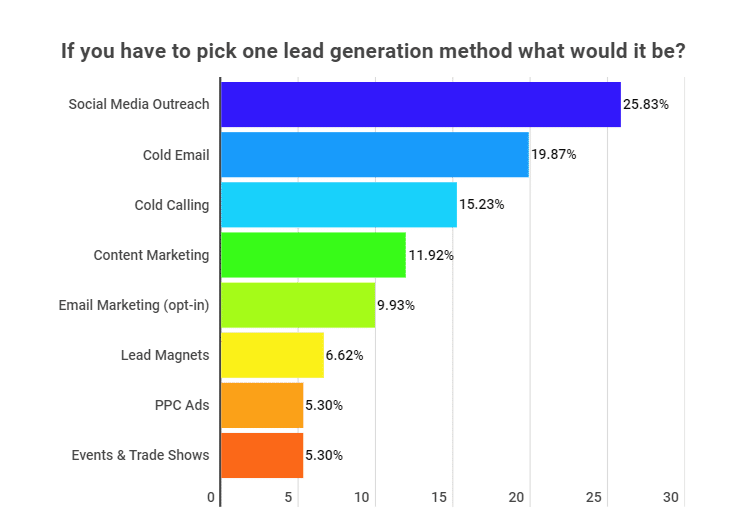
25.83% of the respondents selected social media outreach as their method of choice. Using social media platforms to generate interest and interact with potential customers is vital.
Cold email received 19.87% of the vote to tie for second place. This shows that lead generation initiatives can still benefit from direct communication like emails.
15.23% of respondents chose cold calling as their preferred strategy. While, 11.92% of the responses came through content marketing.
We can also see that 9.93% of the respondents liked email marketing using opt-in lists, which provide incentives to capture leads.
These results highlight the variety of lead generation techniques that professionals prefer. This also highlights the significance of using a multifaceted strategy specific to a target market and business.
Challenges in Lead Generation and Sales
For sales teams, lead generation presents a number of difficulties. The following are some typical difficulties encountered:
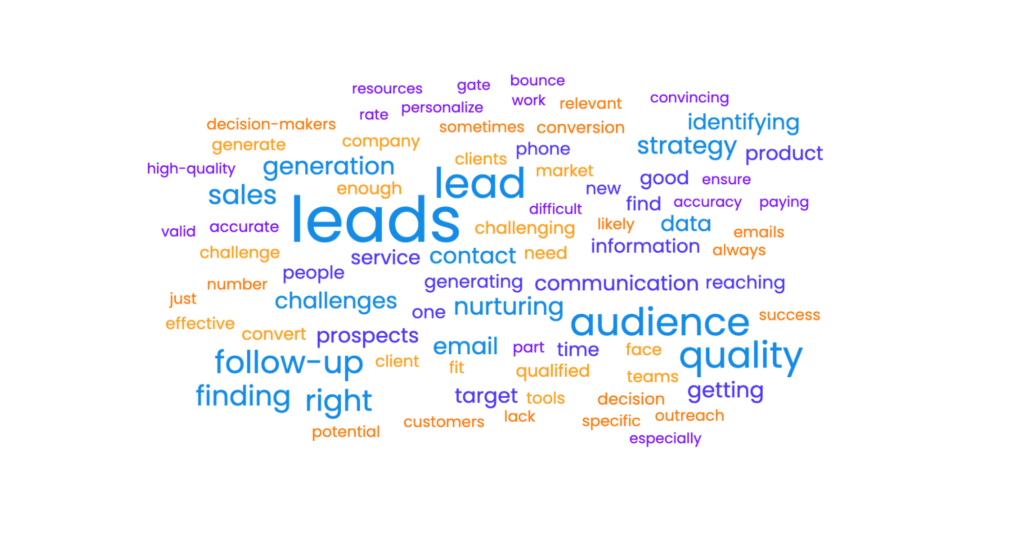
1. Identifying and Reaching the Right Audience
Shaping the clients perspective to fit the audience we’re trying to target. Like how to say it, where to place it and other sort of related questions.
- Identifying the correct decision-makers and target audience
- Determining which leads are most promising
- Finding the ideal clientele who need a certain type of service
- Overcoming opposition and attracting attention
- Ensuring accurate and pertinent leads
2. Lead Quality and Validation
It is challenging to find high-quality leads that are a good fit for the product or service being sold. And also Difficult in reaching decision-makers
- Looking for reliable contact details
- Lead data validation and verification
- Handling stale or inaccurate data
- Preventing cold emails from having high bounce rates
- Evaluating potential customers’ profiles to qualify leads
3. Lead Nurturing and Follow-up
Not all leads are ready to make a purchasing decision immediately. Sales teams need to nurture leads over time, provide relevant information, and follow up consistently to stay top-of-mind until the lead is ready to convert.
- Retaining top-of-mind and nurtured leads over time
- Systematically pursuing leads
- Encouraging potential customers to return calls or emails
- Completing deals and converting leads into sales
4. Effective Communication and Personalization
Personalization is our biggest challenge. The target audience that we work with are sophisticated so we have to heavily personalize our outreach to get their attention.
- Scaling up personalization of outreach initiatives
- Creating content that is compelling and customized
- Convincing potential customers to buy
- Gaining credibility as a trustworthy lead provider and seller.
5. Lead Generation Strategy and Resources
Sales teams need to generate a consistent stream of quality leads that are likely to convert into paying customers. Generating high-quality leads can be a challenge, especially if the company operates in a niche market or has limited resources for lead generation.
- Creating a strategy for lead generation that works
- Generating enough leads to meet demand
- Resources readily available for in-depth investigation
- Improving the effectiveness of lead generation procedures
6. Technology and Tools
Off-the-shelf software/platforms don’t always do what I want. I often have to turn to webhooks, Zapier, or various workarounds that take resources and don’t always work well.
- Coordinating a variety of technologies for managing and validating data
- Using an effective CRM or lead management solution
- Overcoming integration problems with commercial applications and platforms
7. Timing and Market Challenges
Timing – our solution is very much tied to transactions at the client end.
- Matching client planning cycles with leads
- Adjusting to market ambiguities that impact lead creation
Effectively addressing these issues is essential for lead generation success and achieving targeted sales results.
Challenges with Lead Quality
When it comes to the quality of leads, businesses face a number of recurring problems.
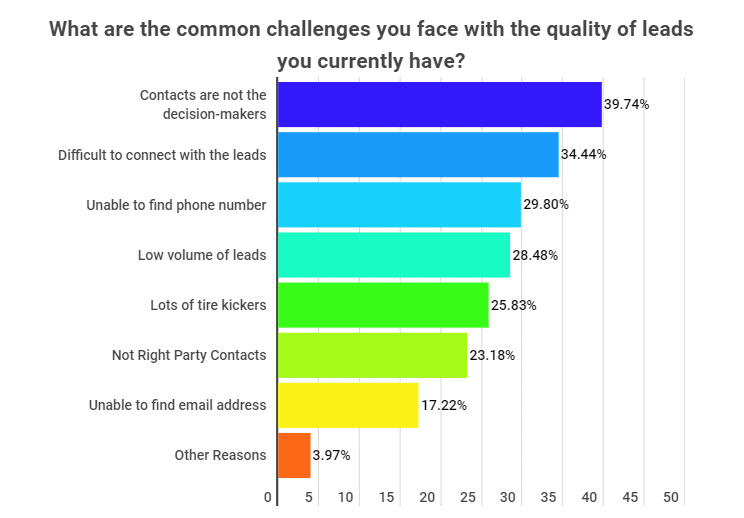
39.74% of people who answered the survey brought up the problem of contacts not being decision-makers. This means the leads developed may not have the authority or decision-making ability within their organizations to further sales prospects.
Second, 34.44% of those who answered said it was hard to get in touch with leads. This can be because leads don’t reply, have incorrect or outdated contact information, or the market is highly competitive.
Lastly, about 29.8% of those who answered were unable to find phone numbers of the leads they created.
Getting past these problems is important for lead conversion and sales success, and it shows how important it is to get high-quality leads that includes decision-makers, good communication with leads, and enough leads to keep and grow sales activities.
Lead Generation and Sales Budgeting
Monthly Budget for Lead Generation and Sales Appointments
The respondents had a range of financial commitments with regard to the monthly budget set aside for lead generation and arranging sales meetings.
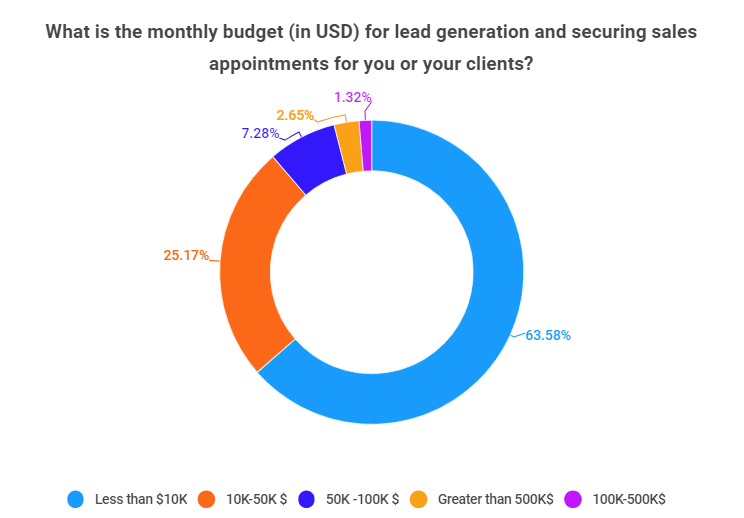
Based on the responses, 63.58% of the people who answered have a monthly budget of less than $10,000 for finding leads and setting up sales meetings. 25.17% of them set a limit between $10,000 and $50,000.
Fewer people (7.28%) have a budget of between $50,000 and $100,000, and even fewer (1.32%) have a budget of between $100,000 and $500,000. Only 2.65% of the people who answered said they had more than $500,000.
These numbers give a general idea of how the respondents use their monthly expenses for obtaining sales appointments and generating leads. It suggests that the majority of responders work within a modest budget range.
Budget Allocation for Lead Generation and Appointment Scheduling
Respondents gave a variety of replies when asked what portion of the sales and marketing budget went toward lead generation and appointment setting.
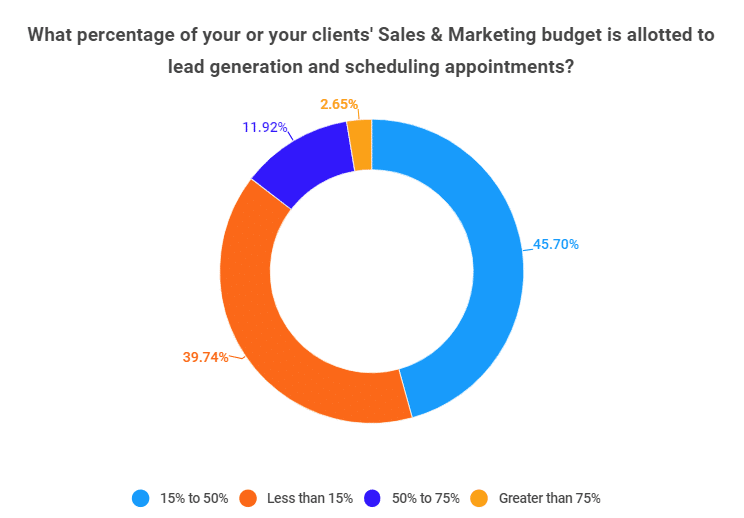
39.74% of respondents or their clients spend less than 15% of their sales and marketing budget on lead generation and appointment setting. A higher percentage, 45.7%, set a budget of between 15% and 50% for these activities.
A lower proportion (11.92%) allocates a budget of between 50% and 75% on lead generation and appointment setting. Only 2.65% of those surveyed stated they spent over 75% of their sales and marketing budget on these activities.
These numbers give us an idea of how the respondents or their clients divide up their budgets. Most of the people who responded spend between 15% and 50% of their sales and marketing spending on lead generation and scheduling appointments.
Preferred Quarter for Lead Generation Investment
Respondents’ opinions for the best quarter to invest in lead creation were varied.
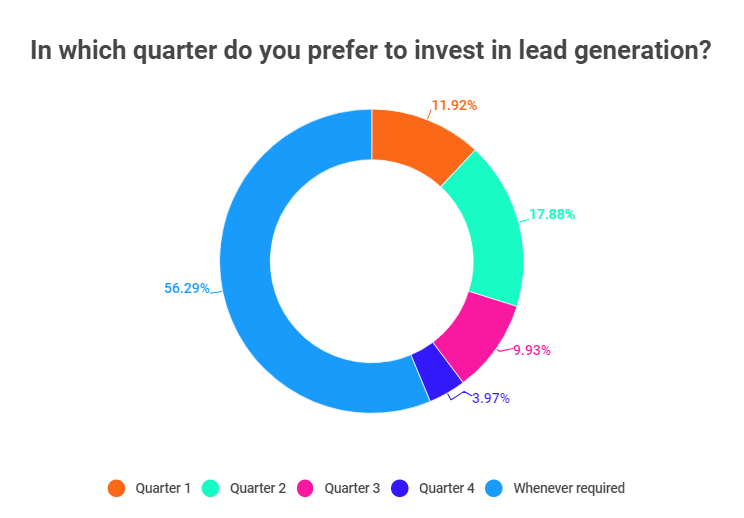
The responses show that 11.92% of respondents prefer to invest in lead creation during the first quarter, while 17.88% prefer the second.
Only 3.97% of respondents prefer Quarter 4 for their lead generation efforts, whereas 9.93% of respondents prefer Quarter 3 for their lead generation investments.
It’s interesting to see that most of the people who answered (56.29% of them) said they spend in lead generation whenever they need to, not just in certain quarters.
This points to an important trend where lead generation techniques prioritize adaptation and flexibility. Respondents want their investments to match the opportunities and needs of the moment so they can make quick decisions.
Metrics for Lead Generation and Sales
KPIs Used to Measure Sales Success
Key performance indicators (KPIs) track sales progress and provide information about the sales process.
Based on what people said, the following key performance indicators (KPIs) appeared to be important for measuring sales success:
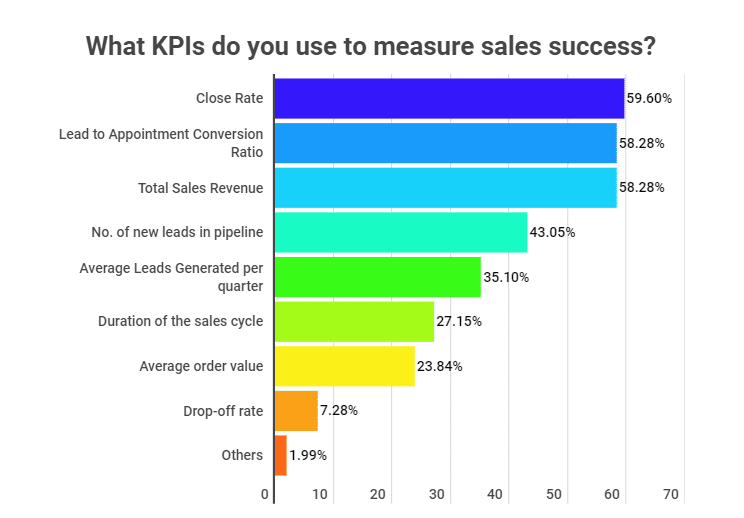
1. Close Rate
59.6% of respondents mentioned the percentage of leads that become customers. It measures the sales team’s ability to close transactions and increase profits.
2. Lead-to-Appointment Conversion Ratio
58.28% of respondents noted this KPI, which measures lead nurturing and qualification efficiency. It measures lead generating success by scheduling leads.
3. Total Sales Revenue
58.28% mentioned total sales revenue. This KPI measures overall financial achievement. It shows sales revenue, indicating sales process effectiveness.
4. Number of New Leads in the Pipeline
43.05% of respondents identified this KPI as the number of new leads in the sales funnel. It determines lead generating success and sales potential.
Collectively, these KPIs shed light on several phases of the sales process and overall sales performance.
Preferred KPI to Measure Success
When respondents were asked to choose only one KPI to measure success, the following preferences emerged.
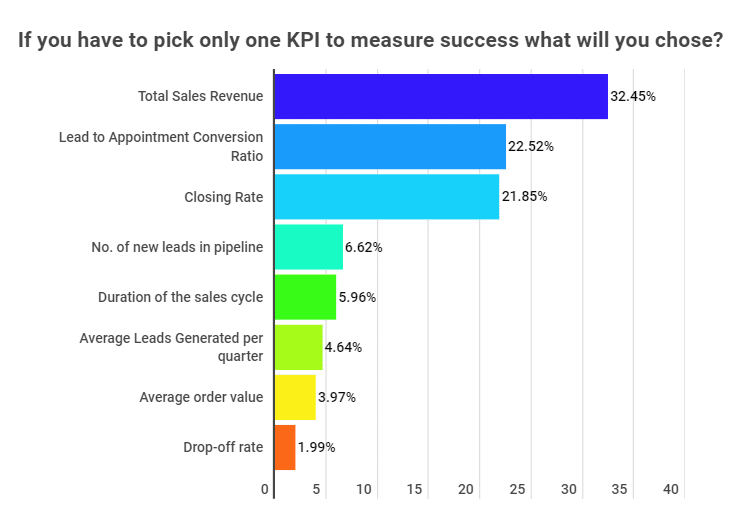
1. Total Sales Revenue
32.45% of those who answered said this was their favorite KPI. It shows how important financial results and making money are when judging the success of sales efforts. The total sales income gives a clear picture of how well the sales team is doing financially and how successful they are as a whole.
2. Lead-to-Appointment Conversion Rate
22.52% of responders prefer this KPI. It shows how leads become scheduled meetings and evaluates lead nurturing and qualifying. A strong sales pipeline and good lead handling shows at a high lead-to-appointment conversion rate.
3. Closing Rate
21.85% of respondents chose this answer. It shows how well the sales team is at turning leads into customers and finishing deals. It shows how well the sales process works and how well the team can get the results they want.
These top three KPIs reveal how crucial financial outcomes, closing deals, and converting leads into customers are to sales success.
By ranking these criteria, firms may see their sales performance and make decisions to improve and increase revenue.
Lead Generation and Sales 2022-2023 Activities
Achieving Appointment/Closure Targets
According to the survey we conducted, the majority of respondents (78.15%) stated that their team or the team of their clients accomplished their appointment and closure targets for the previous quarter.
This suggests they were successful in setting up appointments and closing business within a given time period.
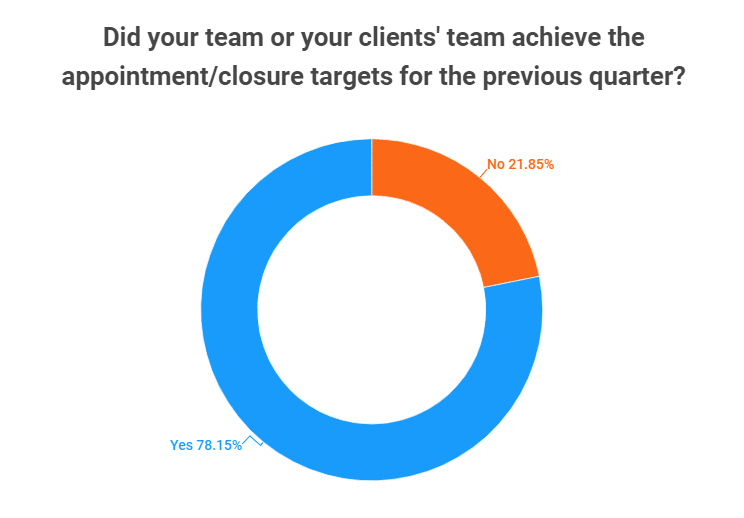
However, 21.85% of respondents did not fulfill their quarterly appointment/closure targets. This suggests they had difficulties or did not achieve their desired results in terms of appointments and finalized sales.
Meeting appointment and closure goals is critical for sales success because it shows how effective the sales process is at converting leads into clients.
Sales teams should evaluate their performance on a regular basis, identify areas for development, and adopt ways to increase their success rate in meeting these goals.
Outsourcing Outbound Marketing Activities
According to the survey, 62.25% of participants outsourced their outbound marketing operations in the previous year.
They sought outside help with duties such as reaching out to potential clients and promoting their products or services.
However, a sizable proportion of companies (37.75%) maintain their outbound marketing initiatives in-house.
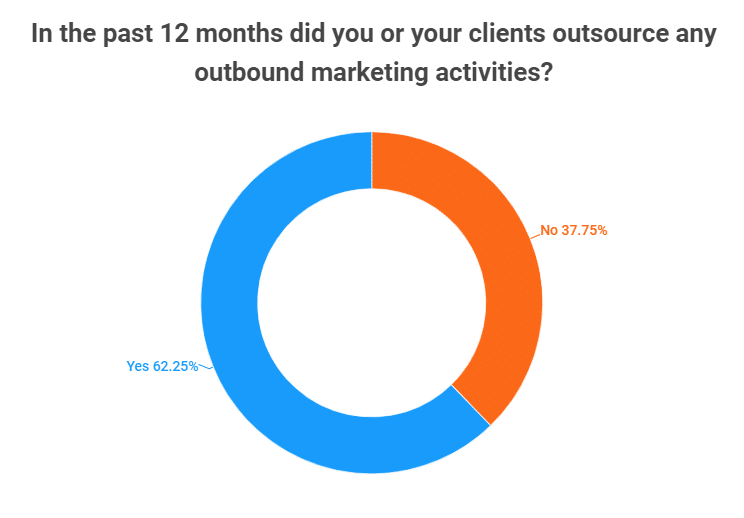
Outsourcing outbound marketing efforts has various advantages. It enables organizations to access specialized expertise, reduce the workload on their internal staff, and potentially achieve better results with professional assistance.
However, whether or not to outsource marketing is determined by criteria such as budget, available resources, and individual business needs.
Finally, while selecting whether to outsource or handle outbound marketing internally, businesses should carefully consider their individual circumstances and aims.
Sales Activities Suitable for Outsourcing
The top three sales activities that can be outsourced according to the survey, are:
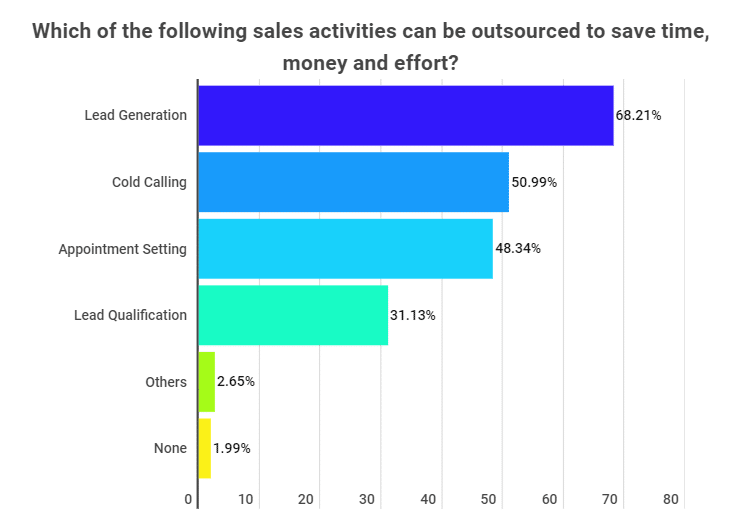
1. Lead Generation
68.21% of respondents believe it is useful to outsource lead generation. Businesses can rely on specialists who specialize in generating high-quality leads by outsourcing. This saves the internal sales staff time and effort while maintaining a steady supply of potential customers.
2. Cold Calling
50.99% of respondents believe outsourcing cold calling is beneficial. This work takes significant time and effort, and outsourcing it allows sales teams to focus on more vital tasks. The initial outreach and qualification process is handled by skilled professionals, allowing the internal team to focus on cultivating connections and closing agreements.
3. Appointment Setting
48.34% of respondents believe that outsourcing appointment setting is beneficial. It can take time to coordinate schedules, check information, and ensure a smooth transition between the sales staff and potential clients. By outsourcing this activity, businesses may streamline the process, save resources, and ensure appointments are planned efficiently.
These sales operations can be assigned efficiently to specialist service providers with the knowledge and resources to optimize results and improve overall sales efficiency.
Average Conversion Rate of Leads to Appointments:
According to the survey, the average conversion rates from leads to appointments for the teams of the respondents were spread:
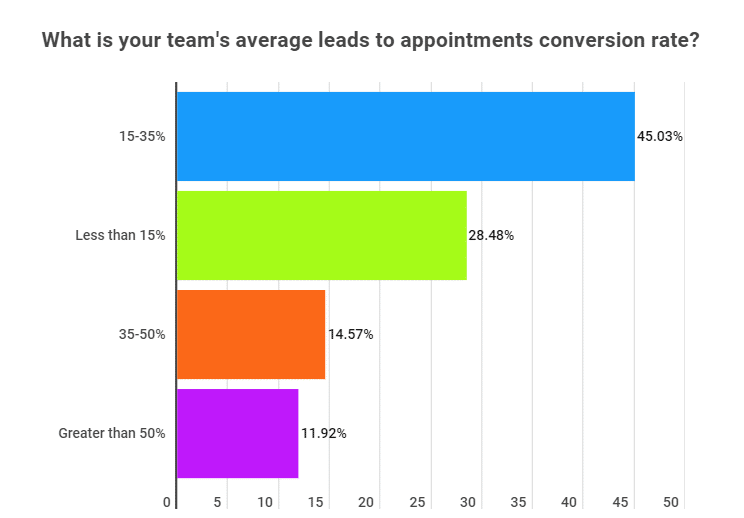
Less than 15%
28.48% of teams had a rate of less than 15%. This means these teams weren’t as good at turning leads into meetings or may have faced challenges in acquiring leads.
15-35% Conversion Rate
The conversion rate for most teams, 45.03%, was between 15% and 35%. This range shows that leads are being turned into meetings about half the time.
35-50% Conversion Rate
14.57% of teams could make a sale. This range says that it is relatively easier to turn leads into appointments.
More than 50% Conversion Rate
Only 11.92% of teams said their conversion rate was more than 50%. This means that they are very good at turning leads into meetings.
When turning leads into appointments, these percentages show how different teams work. It’s important to think about things that can affect the conversion rate, like the quality of the leads, the targeting strategies, and how well the meeting-setting process works.
Unlock Your Growth in a Rapidly Evolving B2B Landscape
We value everyone who worked in sales or lead generation and participated in our survey. Your ideas have helped us learn much about how things are going in this field.
This article highlights the contribution of AI technologies such as ChatGPT and GPT 3 in simplifying the process of generating leads and managing sales leading to their extensive use. The popularity of data focused platforms like ZoomInfo, Apollo.io, HubSpot Sales and MailChimp underscores the significance of data handling and automation, in achieving effective lead generation strategies.
The survey showcases how professionals are adjusting their lead generation approaches utilizing both AI tools and various methods in response to market changes. Their ability to innovate and adapt despite facing limitations is commendable. These findings hold significance for our development and achievement, in generating leads and driving sales.
Thank you for taking part, and we hope to hear from you soon.